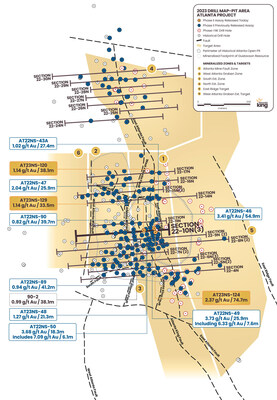NEVADA KING INTERCEPTS 2.37 G/T AU OVER 75M AT A DEPTH OF JUST 12M BENEATH THE ATLANTA PIT, EXTENDS THE ';EAST HIGH-GRADE ZONE' NORTHWARD
- Positive assay results from three vertical reverse circulation holes
- Significant gold and silver mineralization
- Thickest intercept recorded to date along the East High-Grade Zone
- None.
Insights
Analyzing...
Highlights:
Hole No. | From (m) | To (m) | Interval (m) | Au (g/t) | Ag (g/t) |
AT23NS-124 | 12.2 | 86.9 | 74.7 | 2.37 | 43.9 |
AT23NS-120 | 33.5 | 71.6 | 38.1 | 1.14 | 43.4 |
AT23NS-129 | 109.8 | 143.3 | 33.5 | 1.14 | 31.4 |
Table 1. All holes reported today along Section 22-10N(3). Mineralization occurs along sub-horizontal horizons generally dipping gently westward; true mineralized thickness in vertical holes is estimated to be between |
- 2.37 g/t Au over 74.7m in AT23NS-124 starts at a depth of just 12m beneath the pit floor and was sited to test for a northward extension of higher-grade and thicker mineralization hosted within a 20m-wide fault block, termed the "East High-Grade Zone" that runs along the western side of the EAF and floors the bottom of the Atlanta Pit.
- The East High-Grade Zone had previously been intercepted in holes drilled south of Section 22-10N(3) and today's intercept successfully extends this zone 30m northward, injecting higher-grade and thicker mineralization into this area of the AMFZ.
- Since historical explorers did not conduct drilling from within the
Atlanta pit, the East High-Grade Zone was not discovered untilNevada King's 2021 drilling campaign that intercepted high-grade oxide mineralization starting at surface from the bottom of the pit, including 5.34 g/t Au over 54.9m and 3.35 g/t Au over 64.1m (released January 12, 2022, and January 20, 2022, respectively). - As shown in Figure 2, the East High-Grade Zone is atypical in that it hosts grades and thicknesses that are considerably greater when compared to most other mineralized fault blocks comprising the AMFZ.
- AT23NS-120 intercepted 1.14 g/t Au over 38.1m and was positioned 17m north-northwest of AT23NS-124 to define the western boundary of the East High-Grade Zone. The deeper intercept depth relative to AT23NS-124 indicates that AT23NS-120 collared west of the fault bounding the western side of the zone and subsequently drilled down through the boundary fault and into mineralization.
- AT23NS-129 stepped a further 39m west of AT23NS-120 into another drill pattern gap and intercepted 1.14 g/t Au over 33.5m, confirming the presence of mineralization within a westward thickening wedge of silica breccia bounded on top and bottom by shallow-dipping contacts.
Cal Herron, Exploration Manager of
Hole No. | From (m) | To (m) | Interval (m) | Au (g/t) | Ag (g/t) | Notes |
AT21-65 | 3.0 | 51.8 | 48.8 | 2.32 | 32.9 | |
AT22NS-89 | 172.3 | 213.4 | 41.2 | 0.94 | 67.8 | Bottomed in mineralization |
AT22NS-90 | 182.9 | 222.6 | 39.7 | 0.82 | 52.3 | |
AT23NS-48 | 91.5 | 112.8 | 21.3 | 1.27 | 35.1 | |
AT22NS-50 | 89.9 | 108.2 | 18.3 | 3.68 | 27.1 | |
includes | 93.0 | 99.1 | 6.1 | 7.09 | 33.1 | |
AT22NS-47 | 64.0 | 89.9 | 25.9 | 2.04 | 27.8 | |
AT22NS-49 | 62.5 | 88.4 | 25.9 | 3.73 | 46.1 | |
Including | 67.1 | 74.7 | 7.6 | 6.33 | 28.8 | |
AT22NS-43A | 3.0 | 30.5 | 27.4 | 1.02 | 21.2 | |
AT22NS-46 | 4.6 | 59.5 | 54.9 | 3.41 | 26.0 | |
90-2 | 135.7 | 173.8 | 38.1 | 0.99 | 90.4 |
Table 2. Previously reported and historic holes used in Section 22-10N(3). AT21 series hole was drilled by |
All RC samples from the Atlanta Project are split at the drill site and placed in cloth and plastic bags utilizing a nominal 2kg sample weight. CRF standards, blanks, and duplicates are inserted into the sample stream on-site on a one-in-twenty sample basis, meaning all three inserts are included in each 20-sample group. Samples are shipped by a local contractor in large sample shipping crates directly to American Assay Lab in
The Company also announces it has granted 300,000 stock options to a director of the Company with each stock option exercisable at a price of
The scientific and technical information in this news release has been reviewed and approved by Calvin R. Herron, P.Geo., who is a Qualified Person as defined by National Instrument 43-101 ("NI 43-101").
The Atlanta Mine is a historical gold-silver producer with a NI 43-101 compliant pit-constrained resource of 460,000 oz Au in the measured and indicated category (11.0M tonnes at 1.3 g/t) plus an inferred resource of 142,000 oz Au (5.3M tonnes at 0.83 g/t). See the NI 43-101 Technical Report on Resources titled "Atlanta Property,
Resource Category | Tonnes (000s) | Au Grade (ppm) | Contained Au | Ag Grade (ppm) | Contained Ag |
Measured | 4,130 | 1.51 | 200,000 | 14.0 | 1,860,000 |
Indicated | 6,910 | 1.17 | 260,000 | 10.6 | 2,360,000 |
Measured + Indicated | 11,000 | 1.30 | 460,000 | 11.9 | 4,220,000 |
Inferred | 5,310 | 0.83 | 142,000 | 7.3 | 1,240,000 |
Table 3. NI 43-101 Mineral Resources at the Atlanta Mine |
Please see the Company's website at www.nevadaking.ca.
Neither the TSX Venture Exchange nor its Regulation Services Provider (as that term is defined in the policies of the TSX Venture Exchange) accepts responsibility for the adequacy or accuracy of this release.
This news release contains certain "forward-looking information" and "forward-looking statements" (collectively "forward-looking statements") within the meaning of applicable securities legislation. All statements, other than statements of historical fact, included herein, without limitation, statements relating the future operations and activities of
![]() View original content to download multimedia:https://www.prnewswire.com/news-releases/nevada-king-intercepts-2-37-gt-au-over-75m-at-a-depth-of-just-12m-beneath-the-atlanta-pit-extends-the-east-high-grade-zone-northward-302000531.html
View original content to download multimedia:https://www.prnewswire.com/news-releases/nevada-king-intercepts-2-37-gt-au-over-75m-at-a-depth-of-just-12m-beneath-the-atlanta-pit-extends-the-east-high-grade-zone-northward-302000531.html
SOURCE Nevada King Gold Corp.










